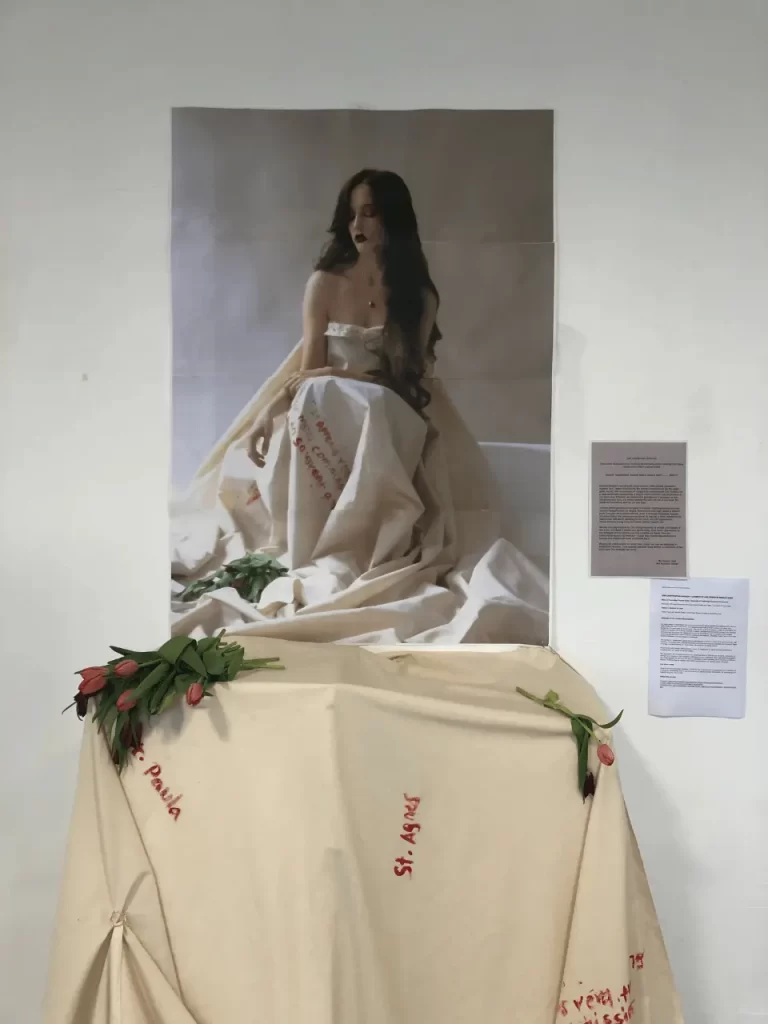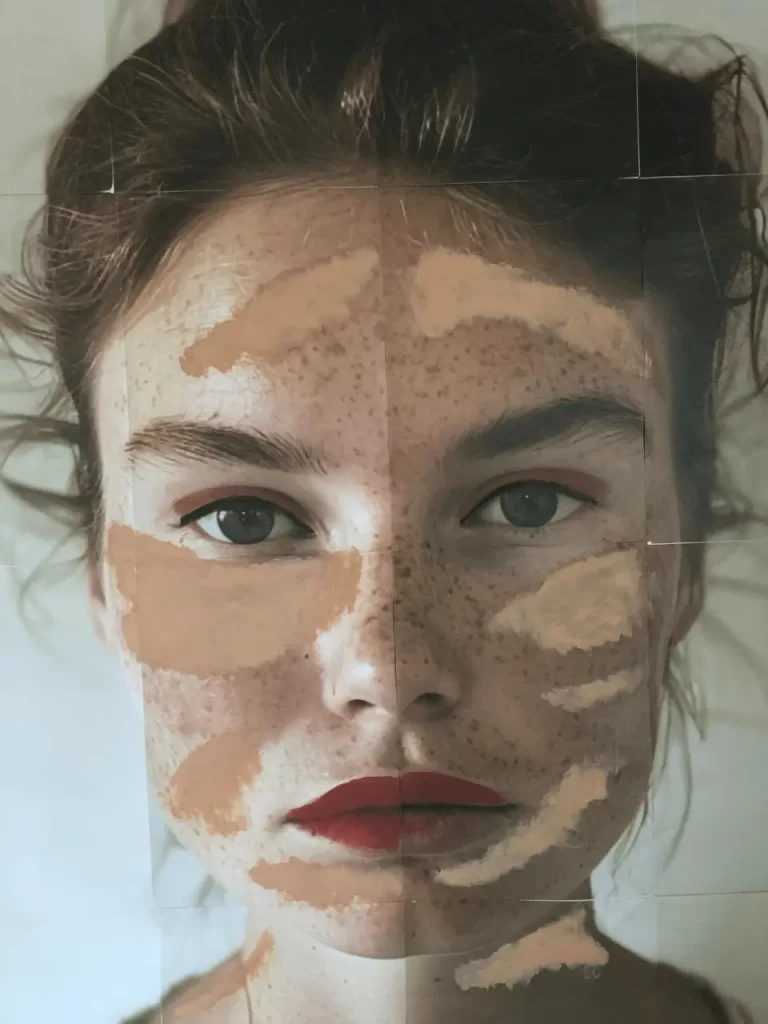During the Cambridge Festival, the CSVPA Graduate School students have been attending a variety of talks, events, workshops and activities under the guise of ‘Artists at Large’. Using their individual disciplinary approaches, and applying their unique perspectives as artists and designers, they have created rapid-response artistic impressions to reflect on and bring to a wider audience what they have seen, heard and experienced during the Festival.
Reflecting back on Women’s History Month, one talk in particular has intrigued and inspired three of our graduate artists. ‘Can a Saint Wear Makeup?’ explores the question: Do respectable women have to look a certain way? Given by Alexandra Zhirnova, from the Department of Anglo-Saxon, Norse and Celtic at the University of Cambridge, the talk explored medieval roots of stereotypes about makeup and dress that still affects women today.

Teamir, MA Fashion Design student
“My eager desire to understand how the past continues to shape present day challenges for women is what initially drew me to this event” explains Teamir. “As a Fashion student with a fervent passion for beauty and aesthetics, I’m fascinated by this dynamic.”
“Through my creative endeavors, I seek to utilise fabric as a medium to illustrate the evolving narrative of beauty, transcending antiquated concepts and fostering empowerment” she continues. “My objective is to convey the richness and complexity of this struggle, honouring the sacrifices women make to challenge expectations.”
Through her creative approach, Teamir celebrates the women in history who defied beauty norms, such as St Brigid and St Agnes. The names of both women, along with quotes from likeminded women, who chose their own paths in the face of societal expectations adorn the material draped around the model and which was exhibited at Friar House. The addition of flowers, almost a commemoration of the women who came before us and paved the way.
“This installation celebrates women’s resilience” adds Teamir, “those who defied expectations and those targeted for doing so.”

Payas, Graduate Diploma in Art & Design student
“Upon hearing about the talk, I was immediately intrigued. The enduring perception of makeup as a deceptive tool wielded by women towards men is deeply ingrained in societal attitudes towards gender, appearance and beauty standards.” Payas explains.
“As someone acutely attuned to the challenges faced by women in our society, I felt compelled to deepen my understanding of these issues by attending the event.”
With only three days to craft a response, Payas produced a video comprising images juxtaposing women with and without makeup with the intention to draw the viewers’ attention to how the right of a woman to present herself, in whichever way pleases her, holds no bearing on how she is perceived by others.
Alongside the video, Payas presented an evocative poster featuring a woman depicted without makeup layered with the same image enhanced with makeup. “This visual representation serves to underscore the reality that makeup merely serves as a tool to augment one’s natural appearance and does not fundamentally alter their essence. Thus, it is fallacious to assert that women who apply makeup are engaging in deceitful practices aimed at men.”
Drawing on personal observations in her native India, Payas concludes: “I aspire to convey a resounding message: a woman’s decision to dress up or apply makeup is predominantly motivated by self-empowerment and self-assurance, with no ulterior motive. Having observed pervasive attitudes in my native India where a women’s worth is often erroneously tied to her relationship with a man, I fervently advocate for the recognition of women as independent and capable individuals who can thrive autonomously. It is high time we dispel the archaic notion that a woman’s existence revolves around catering to the desires of men.”
Pratiti, MA Art & Design student
Revealing what attracted her to this talk, Pratiti said “Medieval makeup is a captivating topic that offers a glimpse into the beauty practices of the past. The medieval church’s ideas about modesty and appearance shaped beauty norms. These notions became lasting barriers to women’s access to power.”
As an Indian classical dancer, Pratiti saw correlations between Medieval European notions of makeup and that of the reputation and exploitation of the Indian temple dancers, the Devadasis, following the colonial era in India.
“The Indian classical dance form originated in the temples of India” she explains. Demonstrating her passion on the subject, Pratiti highlighted how the temple dancers once held a prominent place in society as dancing was considered an essential element of temple worship.
“The temple dancers were not considered as socially marginal before the colonial era which, to a large extent, revolved around the religious imagination and allowed the dance social acceptance. But the dancers themselves were stigmatized, allowing exploitation in every imaginable way possible, after colonization.”
Compelled to explore these parallels, Pratiti crafted a film to visualise her perspective on Alexandra Zhirnova’s research and her own moral position, influenced by the history of Indian classical dance.
“I raised a question about the Medieval European notion of ‘no makeup good girls’ and how this idea potentially influenced the Victorian colonial rulers to change the idea of respect to the Indian performing women artists.”
Approaching a complex and multi-faceted subject, her film explores a woman’s right to choice, interwoven with historical examples of women who followed their own prerogative to dress and present themselves in a way that is true to them.
So inspired by the themes of Alexandra Zhirnova’s talk, Pratiti created a second response. With the permission of St Michael’s Church, in central Cambridge, she performed traditional Indian dance juxtaposed against the backdrop of a Christian church’s alter, once home to those who would have condemned these “wicked women” for daring to insult god by altering their appearance and subsequently demonstrate a lack of modesty. Pratiti replicated the same gestures and movements that would have been performed in the Indian temples to a unique soundtrack, fusing and layering the Buddhist chant ‘Nam Myoho Renge Kyo’ with Christian worship song ‘Agnus Dei’.
“I loved responding to this topic as I am an almost non-makeup person by choice. My first response was to make a very short film raising the basic question about morality and choice – which I think are relative” concludes Pratiti.







